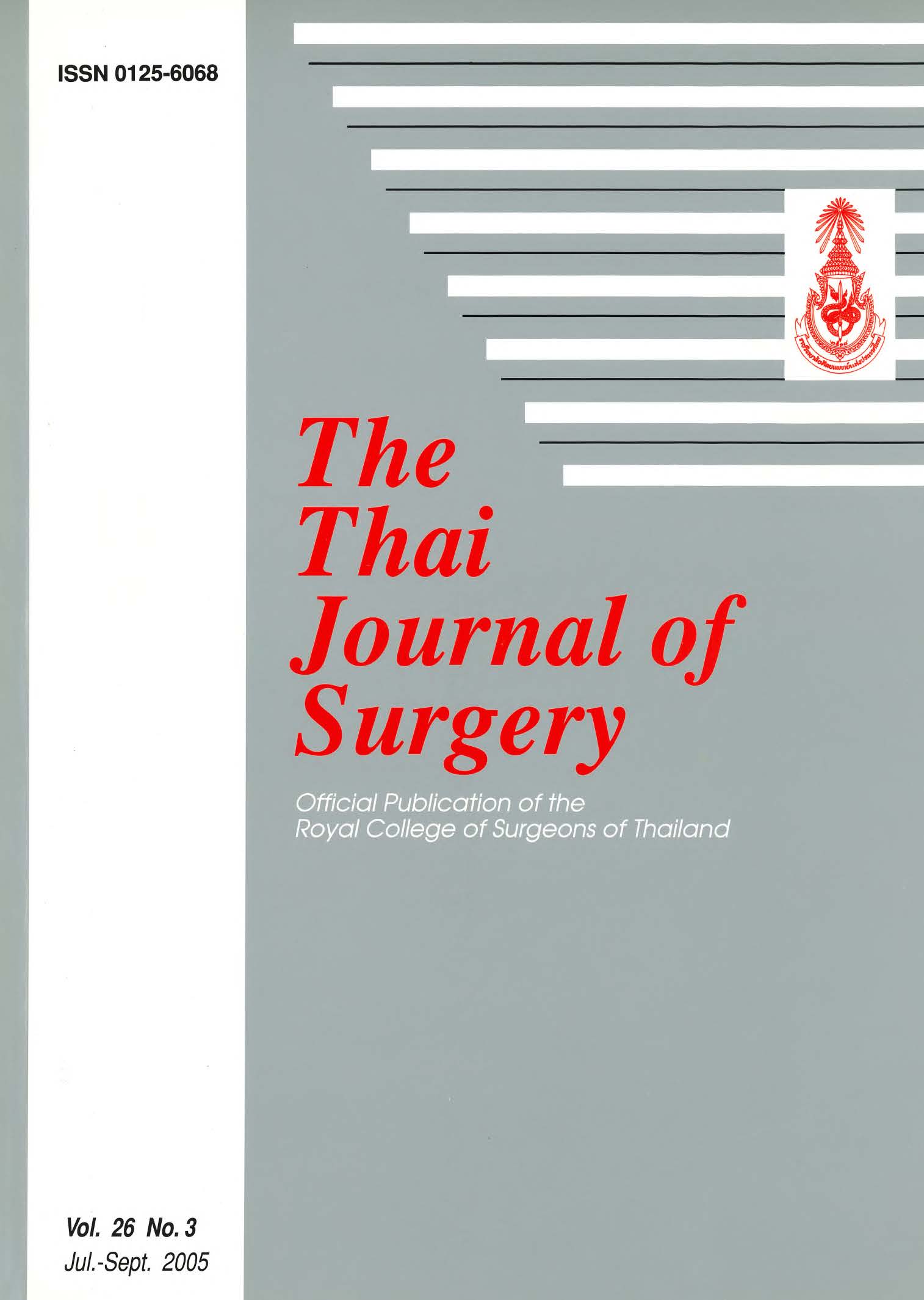Residual Lower Urinary Tract Symptoms (LUTS) after Transurethral Resection of Prostate (TURP): The Urodynamic Studies in Chiangmai University Hospital
Keywords:
persistent or residual symptoms, post TURP, urodynamic studiesAbstract
Background: TURP has been the gold standard in the treatment of BPH since the beginning of the endoscopic era. However, many patients are unable to urinate and the same symptoms persist after this operation. Identifying the causes of symptoms after TURP in BPH patients are necessary for planning and proper management.
Materials and Methods: The retrospective data of 77 post-TURP patients (age 72.66 ± 9.68) having BPH and Lower Urinary Tract Symptoms (LUTS) persisting for at least 2 months were collected from 1988-2004. The number of TURP of each patient was 1-4 times. The underlying causes of LUTS detected by us were interstitial cystitis (IC) in 2 cases, eosinophilic cystitis (EOC) in 1 case, spinal stenosis (Neurogenic Lower Urinary Tract Dysfunction / NLUTD) in 10 cases, and 65 cases only had BPH with LUTS. All were referred to our urodynamic unit for searching for the causes of residual lower urinary tract symptoms. The Cysto-Pressure-Flow studies with fluoroscopy or video-urodynamics were performed in at least 2 successive micturition cycles of each patient in upright position. Male voiding dysfunction classified by Blaivas' criteria was used for interpretation. For statistical analysis of urodynamic variables, SPSS v.2 was used.
Results: There were 32 (41.56%) cases of impaired detrusor contractility (ImC) and of these 7 had NLUTD and 1 had EOC. Sixteen (20.78%) cases had detrusor overactivity (DO) and of these one had IC. Two (2.6%) cases had only bladder outlet obstruction (BOO). Eighteen (23.38%) cases had two conditions, 9 (11.67%) of these had DO + ImC (4 had sphincter weakness incontinence (SWI) due to TURP and 2 of these had NLUTD), and other 9 (11.67%) cases had DO + BOO. Six (7.79%) cases had normal study. Two of these had sphincter weakness (damage) due to TURP. Two (2.6%) cases had incomplete study because they could not urinate during studies. One (1.3%) case was in equivocal group.
Conclusions: All cases of BPH are not necessary causing LUTS. Most post-TURP patients with residual or persistent LU'TS have impaired detrusor contractility (ImC). The second cause of the symptoms is DO. The third is the combination of DO and BOO or ImC. Only 2.6% have BOO alone. Obviously, repeated TURP should not be considered if meticulous physical examination and investigations are not performed because many patients do not have BOO.
References
2. Abrams PH. Investigation of postprostatectomy problems. Urology 1980; 15: 209-12.
3. Abram PH, Farrar DJ, Turner-Warwick RT, et al. The results of prostatectomy: a symptomatic and urodynamic evaluation analysis of 152 patients. J Urol 1979; 121:640-2.
4. Bruskewitz RC, Larsen EH, Madsen PO, Dorflinger T, 3-year follow up of urinary symptoms after transurethral resection of prostate. J Urol 1986; 136: 613-6.
5. Theodou CH, Moutzouris G, Floratos D, et al. Incontinence after surgery for benign prostatic hypertrophy: the case for complex approach and treatment. Eur Urol 1989; 33: 370-8.
6. Nitti VW, Kim Y, Combs AJ. Voiding dysfunction following transurethral resection of the prostate: symptoms and urodynamic findings. J Urol 1997; 157: 600-3.
7. Anutrakulchai S. Detrusor response after TURP in benign prostatic enlargement; an immediate result of urodynamic study. Thai J Urol 2004; 25:1-14.
8. Blaivas JG. Obstruction uropathy in the male. Urol Clin North Am 1996;23: 373-4.
9. Bernier PA, Zimmern PE. Postprostatectomy Incontinence. In: Nitti VW editor, Practical urodynamics. Philadelphia: WB Saunders; 1998. p. 172-83.
10. Haab F, Yamaguchi R, Leach GE. Postprostatectomy Incontinence. Urol Clin North Am 1996;23: 447-57.
11. Abrams P, Cardozo L, Fall M, et al. The standardization of terminology of lower urinary tract function, Report from the standardization sub-committee of International Continence Society. Neurourol Urodyn 2002; 21:167-78.
12. Garraway WM, Collins GN, Lee RJ, High prevalence of benign prostatic hypertrophy in the community. Lancet 1991; 338: 469-71
13. Gormley EA, Griffiths DJ, McCracken PN, et al. Effect of transurethral resection of the prostate on detrusor instability and urge incontinence in elderly males. Neurourol Urodyn 1993;12:445-53.
14. Abrams PH. The urodynamic changes following prostatectomy, Urol Int 1978; 33: 181-6.
15. Kageyama S, Watanabe T, Kurita Y, et al. Can persisting detrusor hyperreflexia be predicted after transurethral prostatectomy for benign prostatic hypertrophy? Neurourol Urodyn 2000; 19:233-40.
16. Winters CJ, Appell RA, Rackley RR. Urodynamic findings in postprostatectomy incontinence. Neurourol Urodyn 1998;17:493-8.
17. Kahn Z, Mieza M, Starer P, Singh VK. Post prostatectomy incontinence: a urodynamic and fluoroscopic point of view. Urology 1991; 38: 233-6.
18. Goluboff ET, Chang DT, Olsson CA, Kaplan SA, Urodynamics and the etiology of post-prostatectomy urinary incontinence: the initial Columbia experience. J Urol 1995; 153:1034-7.
Downloads
Published
How to Cite
Issue
Section
License
Articles must be contributed solely to The Thai Journal of Surgery and when published become the property of the Royal College of Surgeons of Thailand. The Royal College of Surgeons of Thailand reserves copyright on all published materials and such materials may not be reproduced in any form without the written permission.



